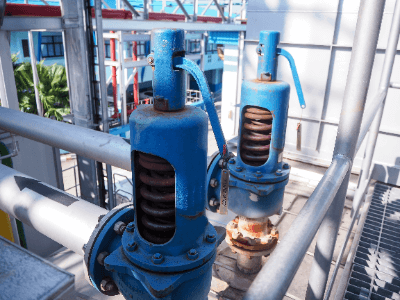What Is a Safety Valve?

Safety valves are installed at the outlet of tanks holding large pressures or positive displacement compressors, such as reciprocating compressors. Safety valves automatically open an internal valve to relieve pressure in the process before an abnormally high pressure builds up in the process that could exceed the design pressure of the tank, or before the compressor is about to break down.
This keeps the process safe. For this reason, they are used in many factories and chemical plants.
Uses of Safety Valves
Safety valves are used to release pressure when the process pressure reaches an abnormal value. For example, in high-pressure tanks, the pressure is constantly monitored and the equipment is shut down before it reaches a dangerous pressure, but safety valves are installed in case of an emergency.
There are also facilities where safety valves must be installed by law. Similarly, they may be installed at the outlet of compressors. In this case, a safety valve is installed to relieve the load on the compressor if the pressure becomes too high.
Principle of Safety Valves
The principle of a safety valve is very simple: a spring holds down the valve plug. By changing this spring, the pressure at which the safety valve starts blowing can be changed.
Some types of safety valves can be adjusted, like pressure reducing valves. However, once a safety valve is blown, it must be replaced because it may continue to blow without being tightened firmly and the pressure at the beginning of blowing may change.
In addition, as a general rule, safety valves should not be opened, so the pressure at the beginning of a blow may be checked once a year during a periodic inspection. One of the most common malfunctions is that when the valve is slightly opened, foreign objects may get caught in the valve and damage the valve plug, or the valve may not be tightened properly and continue to blow. In such cases, it is necessary to clean the valve plug or replace it with a new one to ensure safety.
The outlet of a safety valve must be installed in a safe place to prevent the blowing out of a large amount of gas or other substances under high pressure.
Difference Between Safety Valves and Relief Valves
Safety valves and relief valves are classified into two types according to their function.
Safety valves open fully instantly to release pressure when the set pressure is reached. In a relief valve, the valve plug starts to open when the set pressure is reached, and the degree of opening increases as the pressure rises.
Safety valves are used with steam or gases, and their purpose is to prevent accidents by opening as soon as a dangerous pressure is reached. Relief valves are used with liquids to regulate pressure and prevent pressure buildup due to malfunction.
There are also “pump relief valves,” which are installed at the outlet of the pump and can be used to adjust pressure, prevent pressure buildup due to deadline operation, and provide continuous relief. There are also “safety relief valves,” which have both safety valve and relief valve functions and can be used for both gases and liquids, to be selected according to the use and operating environment.
Selection of Safety Valves
In selecting a safety valve, size and function should be selected as required.
Generally, the size should be one or two sizes smaller than the inlet side pressure reducing valve. The blowout volume should be about 10% of the maximum flow rate of the pressure reducing valve. The set pressure should be slightly higher than the pressure reducing valve pressure. The standard pressure is given in the technical data of each manufacturer.
Next, select the lift method. There are “lift type” and “full volume type,” which are selected according to the application. The full-volume type has 4 to 5 times the blowout volume of the lift type for the same size and is used to relieve hazardous pressure. The full-capacity type is four to five times larger than the Cheng type for the same size blowout volume and is used to relieve dangerous pressure. The Cheng type is often used for pressure adjustment.
In addition, the presence or absence of a lever for checking operation and the type of cap can be selected to suit the use and the environment in which they will be used. With a lever, the operation can be checked at 75% of the set pressure to ensure that there are no abnormalities, such as sticking.
In selecting the cap, the open type releases the blown fluid to the surrounding environment, while the sealed type does not. Select the sealed type if the fluid is dangerous to blow out to the surroundings or if the environment does not allow the fluid to blow out to the surroundings.
Also, the mounting location should be determined so that the mounting posture is vertical since mounting in a sideway or inverted orientation can cause malfunctions.